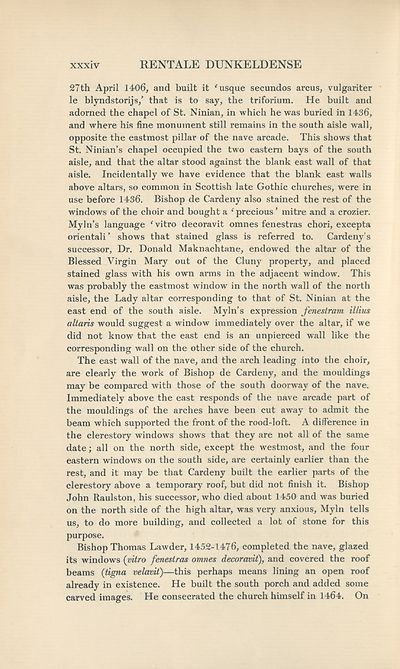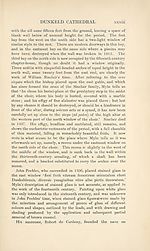Series 2 > Rentale Dunkeldense
(47) Page xxxiv
Download files
Complete book:
Individual page:
Thumbnail gallery: Grid view | List view

xxxiv
RENTALE DUNKELDENSE
27th April 1406, and built it 'usque secundos arcus, vulgariter
le blyndstorijs,’ that is to say, the triforium. He built and
adorned the chapel of St. Ninian, in which he was buried in 1436,
and where his fine monument still remains in the south aisle wall,
opposite the eastmost pillar of the nave arcade. This shows that
St. Ninian’s chapel occupied the two eastern bays of the south
aisle, and that the altar stood against the blank east wall of that
aisle. Incidentally we have evidence that the blank east walls
above altars, so common in Scottish late Gothic churches, were in
use before 1436. Bishop de Cardeny also stained the rest of the
windows of the choir and bought a ' precious ’ mitre and a crozier.
Myln’s language ' vitro decoravit omnes fenestras chori, excepta
orientali’ shows that stained glass is referred to. Cardeny’s
successor. Dr. Donald Maknachtane, endowed the altar of the
Blessed Virgin Mary out of the Cluny property, and placed
stained glass with his own arms in the adjacent window. This
was probably the eastmost window in the north wall of the north
aisle, the Lady altar corresponding to that of St. Ninian at the
east end of the south aisle. Myln’s expression fenesiravn illius
altaris would suggest a window immediately over the altar, if we
did not know that the east end is an unpierced wall like the
corresponding wall on the other side of the church.
The east wall of the nave, and the arch leading into the choir,
are clearly the work of Bishop de Cardeny, and the mouldings
may be compared with those of the south doorway of the nave.
Immediately above the east responds of the nave arcade part of
the mouldings of the arches have been cut away to admit the
beam which supported the front of the rood-loft. A difference in
the clerestory windows shows that they are not all of the same
date; all on the north side, except the westmost, and the four
eastern windows on the south side, are certainly earlier than the
rest, and it may be that Cardeny built the earlier parts of the
clerestory above a temporary roof, but did not finish it. Bishop
John Raulston, his successor, who died about 1450 and was buried
on the north side of the high altar, was very anxious, Myln tells
us, to do more building, and collected a lot of stone for this
purpose.
Bishop Thomas Lawder, 1452-1476, completed the nave, glazed
its windows (vitro fenestras omnes decoravif), and covered the roof
beams (tigna velavit)—this perhaps means lining an open roof
already in existence. He built the south porch and added some
carved images. He consecrated the church himself in 1464. On
RENTALE DUNKELDENSE
27th April 1406, and built it 'usque secundos arcus, vulgariter
le blyndstorijs,’ that is to say, the triforium. He built and
adorned the chapel of St. Ninian, in which he was buried in 1436,
and where his fine monument still remains in the south aisle wall,
opposite the eastmost pillar of the nave arcade. This shows that
St. Ninian’s chapel occupied the two eastern bays of the south
aisle, and that the altar stood against the blank east wall of that
aisle. Incidentally we have evidence that the blank east walls
above altars, so common in Scottish late Gothic churches, were in
use before 1436. Bishop de Cardeny also stained the rest of the
windows of the choir and bought a ' precious ’ mitre and a crozier.
Myln’s language ' vitro decoravit omnes fenestras chori, excepta
orientali’ shows that stained glass is referred to. Cardeny’s
successor. Dr. Donald Maknachtane, endowed the altar of the
Blessed Virgin Mary out of the Cluny property, and placed
stained glass with his own arms in the adjacent window. This
was probably the eastmost window in the north wall of the north
aisle, the Lady altar corresponding to that of St. Ninian at the
east end of the south aisle. Myln’s expression fenesiravn illius
altaris would suggest a window immediately over the altar, if we
did not know that the east end is an unpierced wall like the
corresponding wall on the other side of the church.
The east wall of the nave, and the arch leading into the choir,
are clearly the work of Bishop de Cardeny, and the mouldings
may be compared with those of the south doorway of the nave.
Immediately above the east responds of the nave arcade part of
the mouldings of the arches have been cut away to admit the
beam which supported the front of the rood-loft. A difference in
the clerestory windows shows that they are not all of the same
date; all on the north side, except the westmost, and the four
eastern windows on the south side, are certainly earlier than the
rest, and it may be that Cardeny built the earlier parts of the
clerestory above a temporary roof, but did not finish it. Bishop
John Raulston, his successor, who died about 1450 and was buried
on the north side of the high altar, was very anxious, Myln tells
us, to do more building, and collected a lot of stone for this
purpose.
Bishop Thomas Lawder, 1452-1476, completed the nave, glazed
its windows (vitro fenestras omnes decoravif), and covered the roof
beams (tigna velavit)—this perhaps means lining an open roof
already in existence. He built the south porch and added some
carved images. He consecrated the church himself in 1464. On
Set display mode to:
![]() Universal Viewer |
Universal Viewer | ![]() Mirador |
Large image | Transcription
Mirador |
Large image | Transcription
Images and transcriptions on this page, including medium image downloads, may be used under the Creative Commons Attribution 4.0 International Licence unless otherwise stated. ![]()
| Scottish History Society volumes > Series 2 > Rentale Dunkeldense > (47) Page xxxiv |
|---|
| Permanent URL | https://digital.nls.uk/127382625 |
|---|
| Attribution and copyright: |
|
|---|
| Description | Over 180 volumes, published by the Scottish History Society, containing original sources on Scotland's history and people. With a wide range of subjects, the books collectively cover all periods from the 12th to 20th centuries, and reflect changing trends in Scottish history. Sources are accompanied by scholarly interpretation, references and bibliographies. Volumes are usually published annually, and more digitised volumes will be added as they become available. |
|---|


